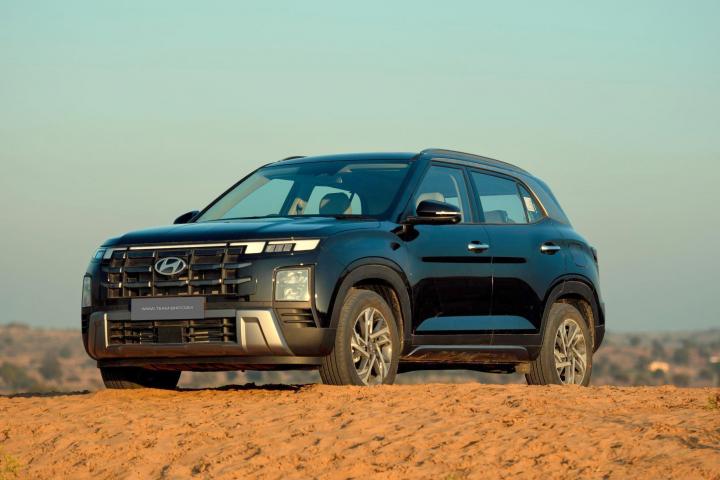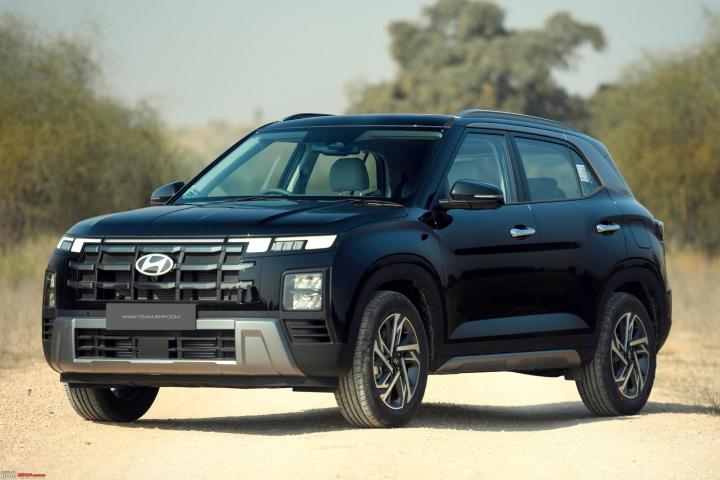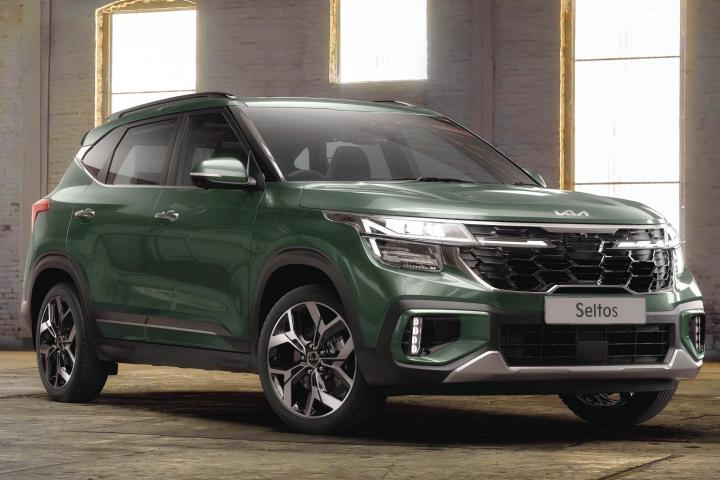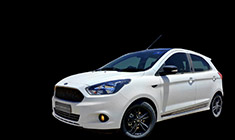News
2024 Creta facelift variants breakdown with top features & prices
Hyundai is offering the facelifted SUV with the new 1.5L turbo-petrol engine that we've seen on the Kia Seltos and Verna.
BHPian Ripcord09 recently shared this with other enthusiasts.
Hyundai recently introduced the Creta facelift in India, with a distinct exterior design and improved interiors. (Review Link). The facelifted SUV receives new tech, a lot more standard safety features and the new 1.5L turbo-petrol engine that we've seen on the Seltos and Verna.
Hyundai has also restructured Creta's variant line-up. Here's a deep dive into all the variants on offer, which will help you identify the most valuable trim for your preferences.

Trims Breakdown
1. E
Top Features
- Projector Headlamps
- Fabric Upholstery
- Front Armrest
- 16-inch Steel Wheels
- Digital MID Cluster
- Rear Reclining 60:40 Split Seat
- Manual AC
- Rear AC Vents
- 6 Airbags
- Rear Parking Sensors
2. EX
Top Features Over E
- Electrical ORVM
- 8-inch Infotainment
- Android Auto & Apple CarPlay
- Front & Rear Speakers
- Steering-mounted Controls
3. S
Top Features Over EX
- 16-inch Alloy Wheels
- LED Headlamps
- Rear-view Camera
- DRLs
- Roof Rails
- Rear Wiper & Wash
- Rear Window Sunshade
- Cruise Control
- Cooled Glovebox
4. S(O)
Top Features Over S
- 17-inch Alloy Wheels
- Panoramic Sunroof
- Dual-zone Climate Control
- Electronic Parke Brake
- Drive Modes
- Traction Control
- Push Button Start
5. SX & SX DT
Top Features Over S(O)
- R17 Diamond Cut Alloy Wheels
- Telematics
- Dual-tone Colours
- Semi Leather Upholstery
- Ambient Light
- Wireless Phone Charger
- Remote Start
- 10.25-inch Infotainment
6. SX Tech & SX Tech DT
Top Features Over SX & SX DT
- Level 2 ADAS
- 8-speaker Bose Audio
7. SX(O) & SX(O) DT
Top Features Over SX Tech & SX Tech DT
- 10.25-inch TFT Cluster
- 360-degree Camera
- Blind View Monitor
- Leather Upholstery
- Front Ventilated Seats
Conclusion
Just looking at what all the variants offer and the price difference between them, the S(O) variant seems the most value for money. It's available with almost all the transmission options for you to choose from. It also stands out for its comfort and convenience features, including split rear seats, automatic climate control, an infotainment system with Android Auto and Apple CarPlay connectivity, a panoramic sunroof and more. The ~Rs. 94,000 jump from the S variant is worth it considering that you get a lot for that money. Also, the jump to the SX variant seems like a considerable jump given that the feature additions are primarily tech-based (e.g. Connected car, bigger touchscreen, etc.).
Do let us know what you think is the most value-for-money variant and also if you had to buy the Hyundai Creta in 2024, which variant would you pick?
Here's what BHPian DivyanshuDiv had to say about the matter:
Voted for SX(O) - that would be my choice as my last pure gasoline car with a turbo engine and DCT before transitioning to electrics or hybrids. However, the most VFM model here as per the spec sheet is Creta S, having a balance of every thing that you need, style as well as substance.
Here's what BHPian anshu1101 had to say about the matter:
Voted for SX (O). Going for the dual tone is a very personal choice.
I always go for the top end while buying a car, given the pace at which technology is evolving in cars these days. Both the cars that I have bought till date have been top-end models only.
Here's what BHPian nri2ri had to say about the matter:
These days, it's hard to make the VFM argument for lower variants especially if you look at it from the perspective that the variant price difference is not going to make or break the decision. If I’m buying a Creta/Seltos/Hector its top end for me.
Only exceptions are superior mechanical packages coming in cheaper (eg:- XUV) or manufacturers continuing to make choices for buyers (eg:- Hycross ZXO not offering the extra seat)
Here's what BHPian BayB had to say about the matter:
SX Tech & SX Tech DT sounds right to me. It has everything I will need here in Bangalore.
Interesting thing is that there was a time when sunroof used to be available only in the top-most variant. Not because of utility value but more for its snob value. Now, its place has been taken by the 360-degree camera.
Check out BHPian comments for more insights and information.
News
First-gen Creta owner's honest thoughts about the 2024 Creta facelift
Hyundai got inspired by Mercedes Benz's wide dashboard displays. The driver's information display (MID) is obviously from the Alcazar.
BHPian Chhanda Das recently shared this with other enthusiasts.
1st generation pre-facelifted Creta owner checks out the 2nd generation facelifted Creta
As most of you may know, Hyundai India launched the long-awaited facelifted 2nd generation Creta in India on the 16th of January 2024 and you surely have seen more than enough reviews of it. However, I had the good fortune of checking it out from close quarters only recently and here are my thoughts on the subject. Better late than never, right?
Aesthetics
From the front, it seems to me that Hyundai was inspired by the Hummer EV (DRLs) while the headlights seem to be lifted almost exactly from the Hyundai Palisade. Overall, I find the facelifted 2nd gen Creta's front to be quite attractive.
From the sides, it seems to have a neutral typical SUVish look and there isn't much to talk about here. Thankfully, they didn't go for the 18-inch rims like those of its sibling Seltos which would have been overkill for our Indian road conditions for a car of this size.
From the rear, it appears to me as if Hyundai got really inspired by the Suzuki Ignis' tail lights and again by the Hummer EV's DRLs when it came to the tail lights which was also replicated in the Venue. I have mixed feelings about this. However, I am absolutely not a fan of the running brake light assembly on the entire width of the rear boot door/lid and it looks particularly horrendous on a white Creta, especially during the day. Overall, the rear of the facelifted 2nd generation Creta does not appeal to me.
Interiors
On the inside, Hyundai obviously got inspired by Mercedes Benz's wide dashboard displays. The driver's information display (MID) in the Creta now is obviously from the Alcazar. Hyundai seems to have cleverly placed a black filter on the dashboard to make it appear as if the infotainment system and the MID are one continuous unit. Overall, it seems quite appealing even though I like manual gauges more than the digital ones. I was pleasantly surprised by the fact that the steering wheel of the Creta is now adjustable for both reach and rake.
I find the dual-zone climate control to be quite useful especially since the average male and female human body temperatures are quite different. However, I was severely disappointed by the aesthetics of the AC control panel which seems quite tacky and appears as if they were taken from a car around 10-15 years ago.
They seem to have done a really good job with the implementation of the ADAS Level 2 functions exactly as I first recall seeing in the Palisade.
It is good to see dull and dark-coloured surfaces on top of the dashboard which would minimize the chances of reflections on the windshield for the driver.
Although Hyundai claims to have increased the use of high-strength steel along with further structural additions and enhancements in the facelifted 2nd generation Creta in India, it remains to be seen how the car performs in crash tests.
Cons
- I would have liked the placement of the ADAS radar at the front to be a bit recessed. Small running animals like cats, dogs, etc and sudden braking of the car along with flying stones from trucks ahead of us are not uncommon on our unpredictable highways. Any impact (even if slight) will damage that radar resulting in expensive repairs.
- The front grille and air dam area have gaps that are large enough for my hand to go in which makes the radiator susceptible to damage from flying stones and other hard debris especially at highway speeds apart from being another point of entry to the engine bay area for rodents. Hyundai could have easily added a honeycomb-like mesh grille like they did in the first-generation Creta.
- They are still continuing with the D-cut steering wheel instead of a circular steering wheel. D-cut steering wheels make complete sense in Formula (F) 1 racing cars which have limited space for the driver's ingress/egress and those steering wheels are completely removable with a single pull as well. Additionally, F1 cars can be turned completely in way less than a single complete turn of the steering wheel. However, a D-cut steering wheel is a safety hazard in a consumer car which needs a few turns of the steering wheel to completely turn the car. Moreover, a consumer car like a Creta does not have the space constraints that would necessitate a D-cut steering wheel.
- Uncovered storage spaces on the dashboard are a safety hazard in case of an unfortunate accident.
- The horizontal shape of the AC air vents means that they won't be able to cover a large part of your body directly which is a problem if you want to use the blower more instead of the AC especially in terms of fuel efficiency.
- The rear middle passenger seat does not have a headrest in the new facelifted Creta 2024. A headrest is very essential for reducing whiplash injuries to the neck. Even my 2017 Creta has this headrest.
- The uncovered Type-C charging ports at the rear are nearly upward facing which makes them very susceptible to dirt and debris ingress. Additionally, there is also the risk of damage from liquid spillages. Water/Juice consumption by rear passengers is not uncommon. And sometimes babies and children do throw up in the car too.
- Hyundai seems to have reduced the amount of plastic cladding in the spare wheel area which means that there will be increased heat ingress into the cabin from the exhaust system resulting in reduced fuel efficiency due to an increased load on the air conditioning system especially in our blistering Indian summers.
- I may be nitpicking here but the tools seem to be in a bag/pouch instead of a properly contoured receptacle area and hence they can rattle on bad roads leading to increased noise, vibrations and harshness (NVH) levels/
- I cannot recommend the uncommon colours of the newly launched Creta because matching the colours after repainting can be really excruciating once the car gets the inevitable scratches.
- I am not too fond of the newly launched 1.5 T-GDi Creta with DCT. Historically, DCTs have never been a reliable transmission over the long term irrespective of the manufacturer. Similarly, GDi engines too have faced reliability issues as early as 5-7 years irrespective of the manufacturer including two-wheeler ones. Add a turbocharger into the mix and we have a potent mixture for higher rates of engine failure due to the high amounts of pressures involved which are dangerously close to diesel territory. Additionally, this engine-transmission combination has not existed in the market for around 3 years which is like the proverbial golden period for cars to exhibit most of their underlying faults.
I believe that our official Team Bhp review has covered the overwhelming majority of all the other aspects very well and I don't think that I have much to add there.
Disclaimer
These are just my personal opinions and may or may not reflect the opinions of my fellow members here. I know this is late and I sincerely apologize for the delay but sadly, I got stuck with some personal work and I could not pay much attention here.
This is all that I can think of right now but I will add more to the list above later if I can remember/notice them. Wishing you all happy and safe drives ahead.
Check out BHPian comments for more insights and information.
News
Why people prefer Creta facelift over Seltos facelift at the same price
While the 2024 Creta facelift lacks many features when compared to the 2023 Kia Seltos facelift, I think there are two factors that might be working in favour of Hyundai.
BHPian 07CR recently shared this with other enthusiasts.
Hyundai recently launched the Creta facelift with great pomp! I was following the launch closely, and having recently purchased (Dec 2023) a GT Line DCT Seltos, I knew the Creta facelift would be launching soon and was curious what it would offer.
For many, however, the Creta facelift somehow turned out to be a slight disappointment. Following could be the reasons why folks on TBHP were a bit disappointed:
- Too conservative/boring external design. Personally, it has grown a bit on me and now the facelift definitely looks better than pre facelift Creta, though not as gorgeous as the Seltos facelift. Even Hyryder looks better than the Creta FL to me.
- Unappealing interiors. Some found the grey interior tone a bit boring again, and a design that feels old already. Centre console with a generous application of Piano black and the AC cluster have been criticized as well.
- Many features missed as compared to facelift Seltos.
Here is the list:
Misses compared to Seltos GT Line and lower trims I have noticed till now:
- No Fog lamps
- Single reversing lamp
- No dynamic mode for the instrument cluster
- Ambient light provided only on the passenger side dashboard (Seltos gets it on the passenger dashboard and both front doors as well)
- Single Orange colored ambient light as opposed to multi color in Seltos
- Absence of rain-sensing wipers
- 17-inch alloys vs 18 in Seltos (This can be a positive point for Creta)
- No 5th passenger headrest
- HVAC system appears too basic in design
Lower trims miss out on a lot of goodies
- In SX trim (HTX+ equivalent of Seltos), Hyundai does not offer Electric seats, the Alcazar's instrument cluster (Basic Verna one is offered instead), No ventilated seats, No Bose Speakers and the likes. All of these are available on Seltos HTX+. Similar story on the S(O) variant of Creta and the HTX variant of Seltos.
- Missing one-touch up and down for all windows
- Absence of illuminated window and door lock buttons, Seltos has all of these illuminated.
- No UV-cut glasses
- Auto dimming IRVM available only on the SX(O) trim. In Seltos, this is available from HTX.
- Front Parking sensors available only on the SX(O) trim. In Seltos, this is available from HTK.
There are some nifty additions over the Seltos too:
- Puddle lamps
- Cooled Glove box
With these shortcomings, I fail to understand why one would go for a facelift Creta compared to a facelifted Seltos. In 2019, people who hated stiff suspension could reject a Seltos, since it was super stiff at that time. But come 2024, Seltos (18-inch wheeled) itself is nearly as good riding vehicle at slow speeds as Carnes (and this car is raved about for its superb ride quality). I experienced this myself, as I had walked in to purchase a Carens, but since the Seltos rode nearly as well, I purchased a Seltos GT Line DCT.
Factors which might tilt the tide in favor of Creta:
- Easy availability of Hyundai dealership. We have a good number of Kia dealerships even in tier 2 cities, but in remote regions, you may find a Hyundai, but not a Kia. Therefore service could be easier in those regions and hence one might go with Creta FL.
- Availability of CVT/NA engine in top spec variant While both Hyundai and Kia offer many trims with varied engine and gearbox operations (IVT/iMT/MT/AT/DCT in Seltos while MT/IVT/AT/DCT in Creta), Kia does not offer the NA engine/CVT gearbox in top spec trim. Thus people who don't need the added performance might settle in for Creta SX(O) IVT.
Any other reasons why you would opt for the Creta facelift over the Seltos facelift?
Here's what BHPian Eddy had to say about the matter:
Personally, I’d go for Creta due to this reason (Availability of CVT/NA engine in top spec variant) alone. And so will a lot of other like-minded conservative buyers.
Here's what BHPian vattyboy had to say about the matter:
I own both of them.
Advantages of Creta
Brand Name
Creta has become a brand in itself. It's an emotion, many people dream of buying Creta once in their life. I have experienced this, The public looks at creta with far more respect. Among relatives and neighbourhoods, Creta has become a testament that you have made it in life.
Better Resale value
Although both Creta and Seltos are coming at the same price initially, down the line after 5 years when you will be in the market to sell your car then from my experience, Creta will fetch you about 1 lakh more than Seltos.
Better Ride Quality
No denying the fact that the ride quality of Creta is far better than Bone's jarring ride of Seltos. Saying this by comparing 17-inch Creta vs 16-inch HTK+ Seltos, can't imagine how hard the ride quality is with 17 to 18-inch alloys.
Better After-Sales Service
If there is one Kia ASS in a City then there are a minimum of 2 or 3 Hyundai ASS in that city. If you don't like the work of 1 ASS then you can go to another one. Also, Hyundai's service network is more widespread than Kia's.
Better rear seat comfort
I can feel that space and comfort at the rear is better in Creta.
Roomy Interiors in the top variants
Creta feels more spacious from the inside due to the beige and grey interiors while in top variants Seltos has a black interior theme.
Here's what BHPian Bit had to say about the matter:
Good threat. I can assume the following:
Service Network: It's not about regular service, but going into outstation/remote areas where Kia might not be present if anything goes wrong with your vehicle during your dream India trip. Folk who want absolute peace of mind that their vehicle can be managed no matter what part of the country they travel to, would often prefer Hyundai to Kia.
Brand Hyundai is Stronger than Brand Kia in our country: For various reasons, people perceive Hyundai as stable, older, and here to stay whereas Kia is perceived as a new kid on the block.
Many people grew up with the dream of getting a particular car. For example, I myself grew up with "I'll get that damn sexy Honda City the day I'll be able to afford". So when these Creta dreamers got in the position to buy a car, they simply did not acknowledge any other car in the market. Kia is not that old to instill such dreams in a generation.
Here's what BHPian ABHI_1512 had to say about the matter:
There is something called 'preference' and 'choice' and I already see a lot of buyers opting for Creta and not Seltos. Despite so many variants of Seltos, the petrol manual has no top trim and the absence of a diesel manual has been corrected only recently. Creta and Seltos despite being similar are poles apart in terms of styling as well. So, yes, there are customers who would take the Creta over Seltos and vice versa which fits into their requirements.
Check out BHPian comments for more insights and information.
News
Confused between 2024 Creta facelift and 2023 Seltos facelift
I feel more inclined towards Hyundai due to features like ADAS which isn't available in Kia yet.
BHPian abhi3284 recently shared this with other enthusiasts.
I am contemplating between Creta and Seltos (Petrol Auto) to replace my 12-year-old Ritz D Manual and it sure is not an easy task choosing among the two. Confused between IVT and DCT but am preferring IVT due to it being more reliable and with better fuel economy compared to DCT. I have test driven both Seltos (Petrol DCT) and the new Creta (Diesel AT). Unfortunately, IVT Auto variants were not available to Test Drive for both cars and am waiting to Test Drive them soon.
My observations after driving both Cars are as below:
- Personally, for me, New Creta looks more Classy and better with clean lines, Exterior looks wise. Seltos looks good as well, but looks slightly overdone to me and I did not like the Chrome strip at the front.
- Creta Interiors Color scheme did not look that great with light grey and cream when I checked it the 1st time. On my 2nd visit, when I spent some time inside and during the Test Drive, it was looking the more inviting, classy and roomier cabin. For some reason, the Seltos DCT Cabin looked a bit smaller and claustrophobic, maybe due to the dark color interior scheme. To add, both my Wife and Daughter felt the same and voted for the Creta. Not sure if it is going to be a task to maintain the interior though.
- To me, the Door of the Creta felt more heavy and assuring than the Seltos. Now, it can also be because the Creta was a new one and Seltos might have been abused a bit. Still, Creta felt better to me.
- Lot has been talked about the Interior Design Layout and the Glossy Black Infotainment and the majority opinion is that Seltos' Layout is the better one. The front infotainment panel layout being inverted to the Seltos one, is not a concern to me and I maybe prefer the Creta layout more as the whole dashboard is in a straight uniform line. Honestly, I don't mind either of them, coming from a Ritz D Interior Layout. Both look good to me. So, not a major deciding factor for me.
- Ride was plush, stable with good NVH levels in both of them but will not elaborate more, as I am more interested in IVT. Front visibility was also good in both, but I felt it slightly better in Creta with bonnet ends clearly visible. Seating comfort at the front and back was good in both of them.
- In base or mid variants, it is true that Seltos offers more features than Creta, but I feel it is pretty close in the top-end variants for both. Yes, Creta does miss out on One touch-up down for all Windows, Fog Lamps, Rain sensing wipers and Middle Passenger Headrest.
- What might tilt the balance towards Creta is that I am thinking of going for the variant with ADAS and 360 Deg Camera, as I don't change Cars that often. And it is only Creta that offers it in the IVT top-end variant. Seltos does not, so far.
- One thing that bothers me is the large gap in the front grill where anyone can slide their hand in and cause damage if any malicious intent and also the sensor or fuse that sticks out behind the Front Grill. Any idea what that sensor is for and are both of these concerns valid?
I plan to make a booking before this month's end and hope for delivery in the next 2 months. Hopefully, the IVT variant will be available for Test Drive before that.
Had a few queries regarding the same and if someone can clarify my doubts, that would be great.
- Is the rubber band effect felt prominently in the Hyundai IVT Engine or is it not noticeable? How is it compared to CVT in Elevate, where I have read that the Rubber Band effect is prominent?
- Is there any performance difference between the IVT Engines in Hyundai and Kia, tuning-wise or how it responds to accelerator input?
- Does the performance of IVT engines degrade over time, in regard to Acceleration response time or Engine Noise / NVH Levels? Or does it stay consistent?
- Has anyone managed to Test Drive the new Creta in IVT form and any feedback on the same would be appreciated.
Looking forward to inputs from our esteemed members.
Here's what BHPian 07CR had to say about the matter:
It is indeed a point of concern for me IMO. Not because of the malicious intent of others, but more because on the highways at high speeds, a lot of stones, pebbles and whatnot keep bouncing off. I am concerned about how much such things might impact the engine bay because anything can enter there easily. You will also need to keep a watch for sparrows, cats, rats, snakes etc easily hiding there (Yes, it's that big!).
Here's what BHPian Aviator_guy had to say about the matter:
Though I have not driven FL Creta/Seltos, we have both the current gen IVTs in the family so I can answer some of your questions since the engine is the same in the FL model.
IVT is very smooth and silent in city driving conditions. You may find some rubber band effect on highways, especially during quick overtakes. However, if you are not looking for pedal-to-metal driving and are a calm, relaxed driver then IVT does the job very well.
Both Creta and Seltos have the same engine and same tuning so performance-wise, both are identical.
Creta is 2.5 years old and Seltos is 2 years old and there is no degradation in performance. IVT has been doing the job very well and the NVH level is excellent. Usually, the CVT engines (IVT in Hyundai language) are low maintenance and long-lasting so I don't expect it to degrade over time.
Here's what BHPian ShabbyG had to say about the matter:
I am in the same boat as you - upgrading from a 2011 Ritz Diesel. Took a test drive of Creta IVT yesterday. I would say the drive comfort in Creta is slightly better than the Elevate and definitely better than Seltos (For reference, I drove in Bangalore where the roads are generally scattered with potholes).
The IVT response is the same as Seltos. You can feel the rubber band effect in Eco mode. But, Sports mode masks it quite well (much better than the Elevate).
Coming from Ritz diesel, I can confidently say that you will not feel much of the rubberband effect even in Normal mode either unless you have been driving newer cars. But, there is no way we can compare to DCTs or ATs.
The engine is super silent - IVT or manual doesn't make a difference here.
The biggest factor tilting the scale in favour of Creta is the AutoHold feature availability in the lower automatic trims while Seltos only has it in the top trim.
The center console on Seltos is better than that on the Creta. But home ministry is valuing the AutoHold feature over other features that Seltos provides.
I would have asked you to try the GV as well due to it having a torque convertor. But, when I entered the car, everything other than the center console reminded me of the 13-year-old Ritz. And you are also a Ritz owner.
IMHO, if you stay in a city like Bangalore with pothole-filled roads and min 70% of the drive is in the city, prefer Creta otherwise, go with Seltos. You can't go wrong with either.
FYI, I had booked an XUV700 earlier but had to drop it due to family continuously raising concerns about its size (We are a family of 4 with the youngest one being less than a year old). Once you drive the XUV700, it is difficult to be satisfied by a compact SUV in terms of either performance or drive comfort.
Check out BHPian comments for more insights and information.
News
Checked out the 2024 Creta in-person: My observations as a City owner
If you try to draw comparisons with the 2023 Seltos, the Creta might obviously underwhelm you, design wise.
BHPian CentreOfGravity recently shared this with other enthusiasts.
Today when I was coming back home from school, I passed a Hyundai showroom which is near my house and noticed that the Creta had arrived. Immediately after reaching home, I changed my dress and off I went to check out the Creta facelift.
Keeping in mind that we have no plans to buy a new car for atleast a decade and that we own a 2022 Honda City, here are my observations:
- I find the design to be better than the outgoing car. In fact, the SA too had the same opinion. However, if you try to draw comparisons with the Seltos, the Creta will obviously underwhelm you, design wise (subjective). While I do like it, I don't love it.
- Just like in the Team-BHP review unit, a sensor was exposed behind the grill. On asking the SA, he said that it could be a sensor for the ADAS (he wasn't sure). Shoddy work by Hyundai there.

The showroom display car was shod with 215/60 R17 Apollo Almac tyres.

Rear section looks smart, except the reversing lamp. Hyundai could've easily accomodated them in the reflector housing or in the taillight cluster between the block-like taillight units, here:

Interesting detailing on the upper portion of the taillight cluster. Also notice the Hyundai logo behind the glass (?) panel. Tastefully done:

Isn't the font of the "CRETA" badging the same as that of the first gen?

- The doors did not feel very light. In fact they had a decent amount of heft, especially when compared to the Honda City.
- I shut the front passenger door rather gently when the window was slightly open, and I was startled when I saw the window shake the way it did.
- Backseat experience: The back rest angle was pretty good and it seems you can adjust the angle, although the lever seemed stuck when I tried adjusting it.
- At ~5' 8'' I am pretty short, yet I find the City's headroom in the backseat kinda lacking. Enter the Creta, and I had a hand-span worth of headroom (~8 inches!) compared to 4-5 inches in the City:

Compared to the City, knee room is slightly less with the front passenger seat set to my position. Under thigh support is lacking though, both when compared to the City and on its own. However, no complaints about leg room:

The seats are noticeably firmer than the City - this should probably be comfy over long trips. The centre passenger won't feel unwelcome since the central tunnel isn't too intrusive, but his head sure will; there is no centre headrest you see..
While on the topic of centre passengers - the seatbelt mechanism looks weird, but interesting to me. The belt is pulled from the LHS on top, and then slotted into two buckles - the second one locks you into place. No such complications in the City. A picture is worth a thousand words:


Notice the copper piping in the rear seat as well. Also notice the clever slot for the seat belt:

The front armrest isn't the sliding kind. Also, while closing it, the armrest doesn't slot in place; it just closes. The storage is deep enough though. Rear AC vents have a smooth, velvety feel while operating:

I'm shocked that the grab handles aren't dampened! The driver's side misses out on it altogether. LED cabin lights are present near the grab handles.
Note the absence of hooks; they aren't present on either side:

Panoramic sunroof sure lends the cabin an airy feel. Also, it doesn't affect head room all that much.
Here's how the cabin looks from behind:

Continue reading BHPian CentreOfGravity's review of the 2024 Creta for more insights and information.
News
Hyundai Creta facelift: 6 key observations from our showroom visit
We own the pre-facelift Creta and can definitely feel the difference.
BHPian Col Mehta recently shared this with other enthusiasts.
Happened to visit a nearby Hyundai showroom and here are a few observations:
- Looks good! I was one of those who criticized the exterior of the new car initially, but it looks a lot better in person. Especially, the front is now more imposing and there is a very apparent difference in the bonnet height and creases. The rear looks quite good too and not as bad as some of us thought.
- Hyundai has claimed that they have worked on the build quality of the new Creta and it DOES feel that way when you open the doors and interact with the car. Our 2nd gen (pre-FL model) feels lighter which has always been my complaint with it. Hyundai seems to have addressed it. Hopefully, it will reflect positively in the crash test.
- The overall length has gone up from 4300 mm to 4330 mm (most likely because of updated bumpers), and the difference is hardly perceptible. But it looks more butch and boxy as a result of updated design elements.
- The interior is a mixed bag. While it looks more premium, especially with the new dual screen setup and dashboard, the grey colour theme and that HVAC system with cheap creaking plastic brings down the cabin experience. The new HVAC system is not too bad in terms of how it looks, but it’s just not very premium-looking. Wish Hyundai had given a more subtle and sophisticated system.
- As per the Sales Manager, the air purifier has been removed which is a bummer. Yes, I know a lot of people call it a gimmick, but it was good to have a feature. The centre armrest looks incomplete(?) without it IMHO.
- The seat pattern has been refreshed which looks better than the outgoing model. And did I mention the view from the driving seat is now more commanding with the increased elevated bonnet..? We could easily feel the difference and liked this one.
Overall, I think it’s a good midlife refresh from Hyundai. I’m pleased with a lot of things, including that it feels better built. However, Hyundai should have worked on improving plastic quality - the centre console still creaks and the HVAC system is not that premium.
My rating based on today’s experience - 8/10.
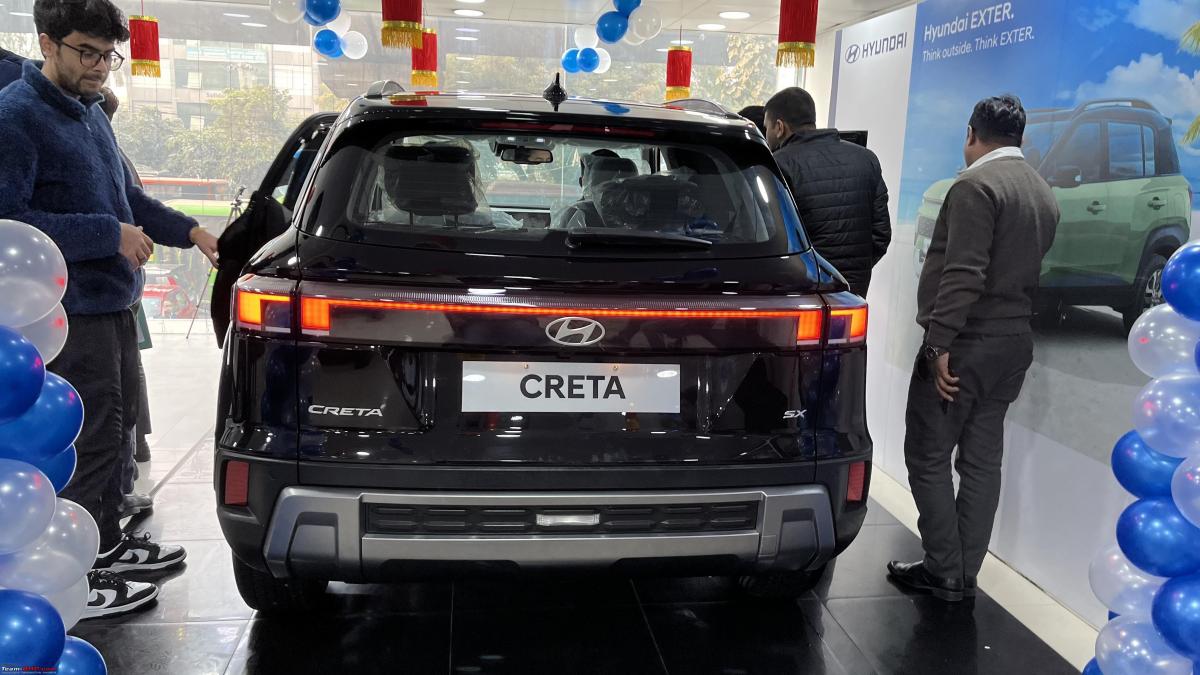
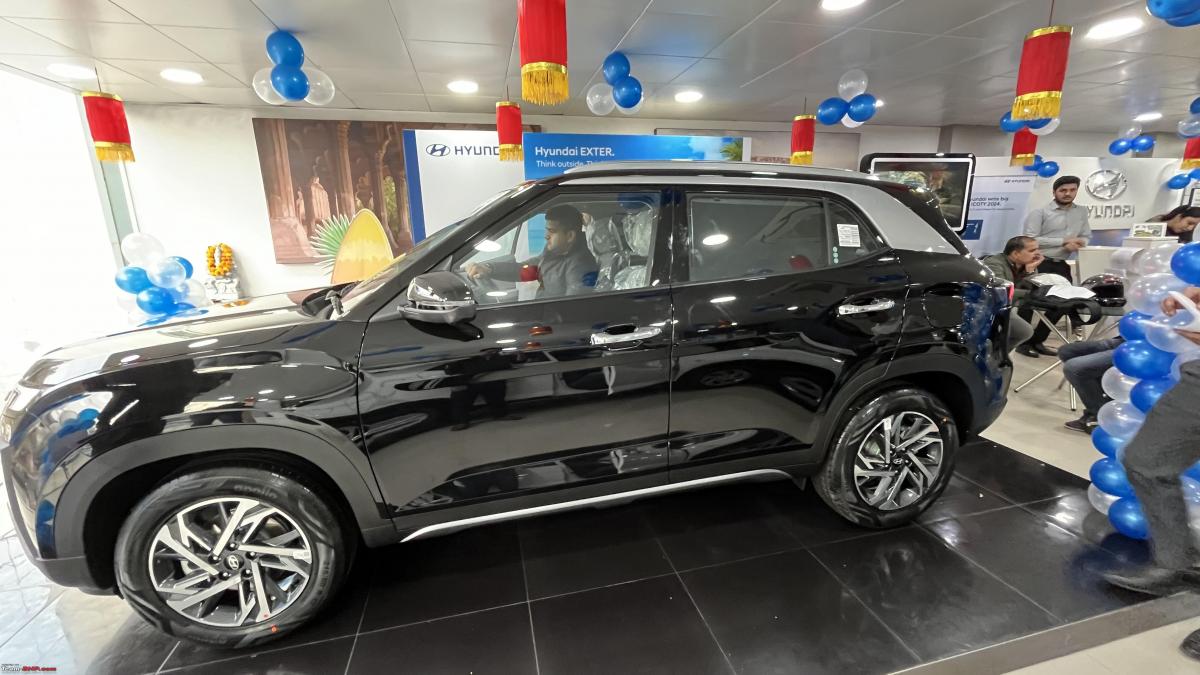
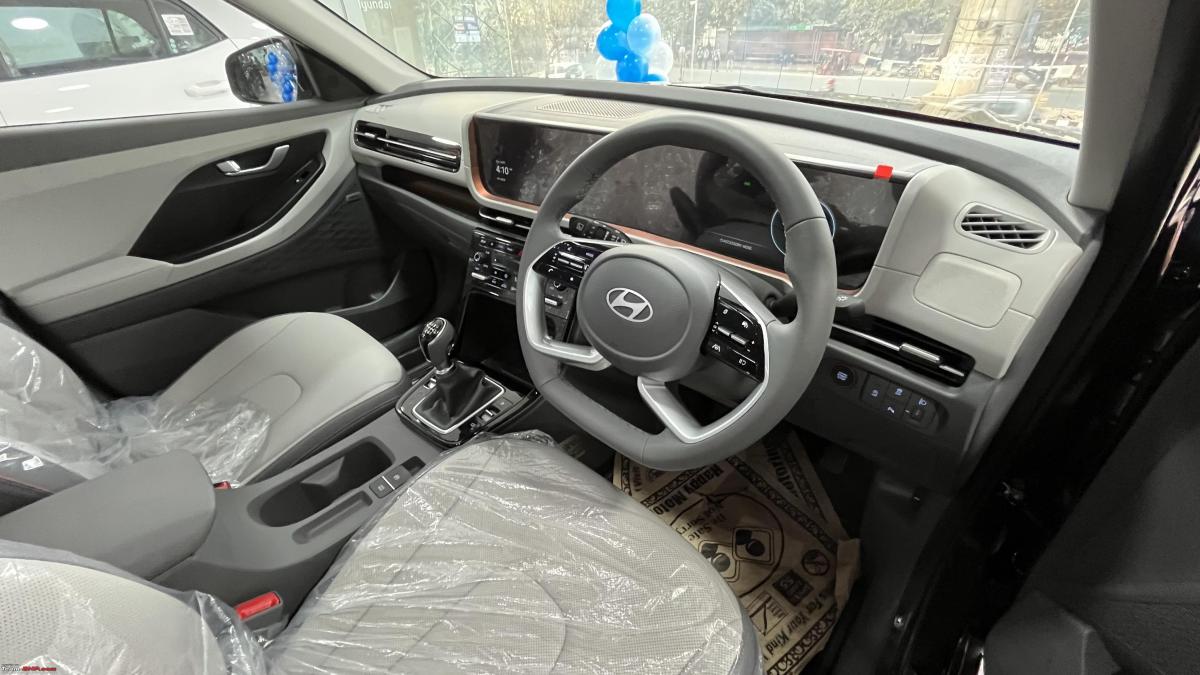
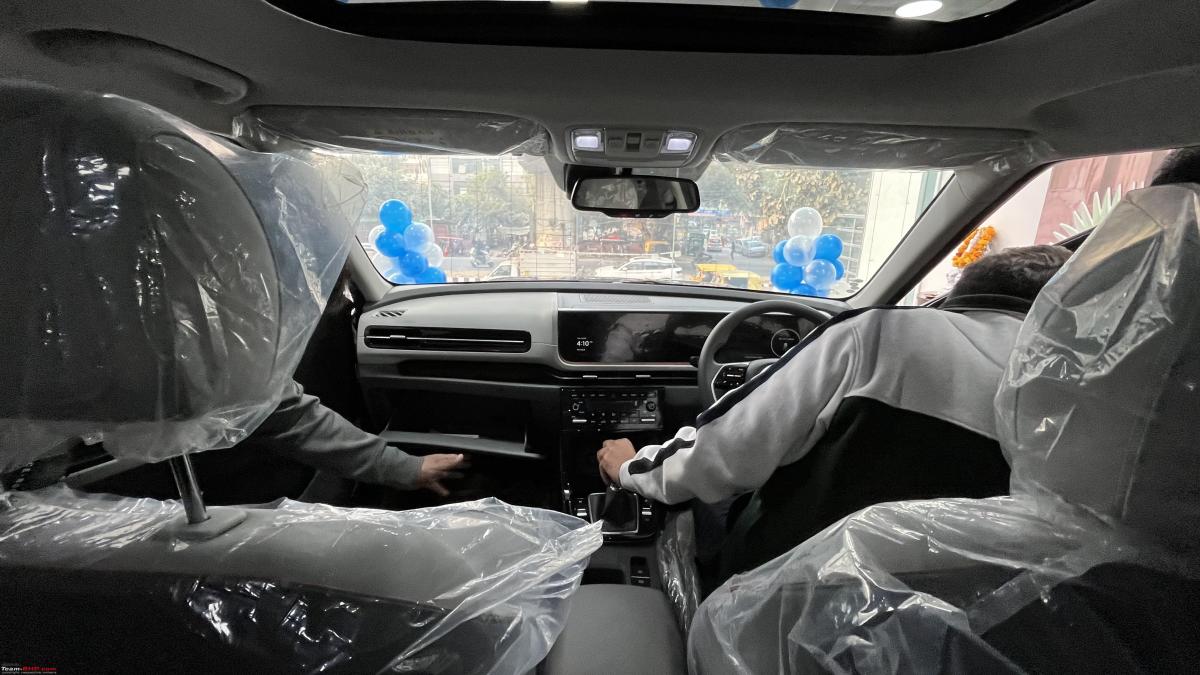
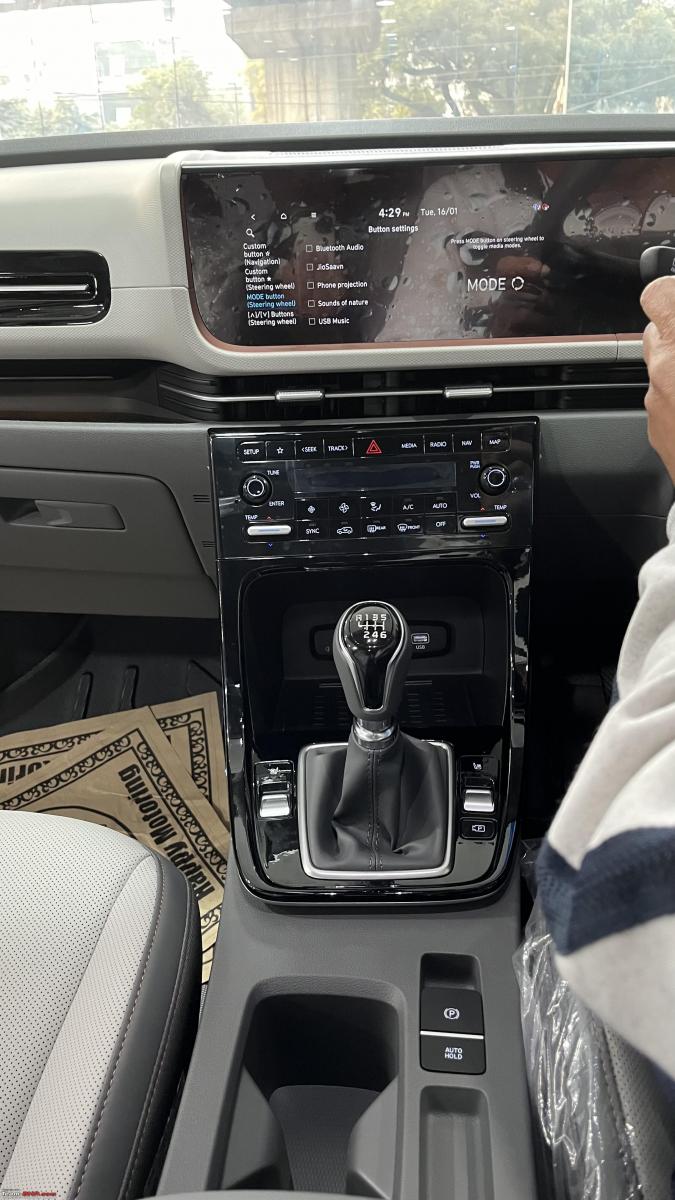
Check out BHPian comments for more insights and information.
News
Hyundai Creta Facelift : Our observations after a day of driving
Get on some open roads and you can let the Creta stretch its legs. Put your right foot down and before you know it, you’ll hit the highway speed limit of 120 km/h.
Driving the Hyundai Creta 1.5L Turbo-Petrol DCT Automatic
The 138 BHP, 1.4L Kappa turbo-petrol engine mated to the 7-speed DCT in the outgoing model was quite powerful and quick. However, the engine had to be upgraded to meet the prevailing emission norms. The result is this Smartstream 1.5L turbo-petrol engine which still belongs to the Kappa family and makes an impressive 158 BHP and 253 Nm and is shared with the new Hyundai Verna and the Kia Seltos facelift. The Hyundai-Kia siblings have the best performance figures in the segment. The 1.5L turbo-petrol engine is only available with a 7-speed DCT automatic and doesn't get the 6-speed iMT that the Seltos gets.
Fire up the engine, and it's refined at idle, silently purring away. Hyundai-Kia powertrains have always set NVH benchmarks, and this car is no different. Shift to D or R, and it crawls away smoothly. Crawling at city speeds isn’t very dramatic and the 1.5L is very well-behaved. With light to medium throttle inputs, you can go about your daily commute quite comfortably. In comparison with the old 1.4L turbo-petrol, the throttle response is smoother and power delivery is more linear. The 7-speed dual-clutch transmission is also seamless moving through the initial gears. However, we did notice that the gearbox got a little confused on a few instances while driving through some traffic. There was also an instance where the gearbox upshifted on its own when coming down a slope without any throttle input. This was strange as we'd have expected it to hold the gear. Start driving and you will appreciate the healthy low-end of this engine. Thanks to the turbocharger and direct injection, you’re never at a shortage of power. Just floor the accelerator if you want to close a gap in traffic or make that quick overtake and the engine and gearbox will do the rest.
Get on some open roads and you can let the Creta stretch its legs. Put your right foot down and before you know it, you’ll hit the highway speed limit of 120 km/h. This is the thing with turbo-petrol engines - flooring the throttle on an empty stretch of road can get addictive. Outright acceleration is great and it feels a little more linear as well compared to say, the 1.5 TSI from the VW-Skoda cars. The turbo delivers a strong mid-range punch that will take care of all the overtaking on the highway. You can cruise along the highway at 100 km/h while the engine spins at a relaxed 1,800 rpm. Even at 120 km/h, the engine felt relaxed with the rev counter reading 2,200 rpm. The Creta won't break a sweat cruising at these speeds all day long.
The dual-clutch transmission moves through the gears seamlessly. The kickdown response time is quick enough and the gearbox doesn’t hesitate to drop down 3 or even 4 gears at times to get the engine into the powerband. When you are in the mood for some fun in the ghats, switch to Sport mode and start flipping the paddle shifters for manual control. The ECU matches the revs which is always very satisfying. In comparison to the Kia Seltos, the Creta doesn't sound very happy at high revs. And while the overall NVH package is good, the engine doesn't sound very sporty at high revs. Hyundai has restricted the maximum rpm to 5,900, which is too low, and the engine sounds a bit strained at this rpm. The paddle shifters are responsive, and you can extract some performance from the engine using them for quick overtakes or keeping the engine in the powerband on some twisties. What's different from the Hyundai Verna and the Kia Seltos facelift is that the gearbox gets an "S" mode in the Creta. You can engage it by sliding the gear lever to the right (when in D) and this makes the gearbox hold on to the gears a bit longer. You'll appreciate the gearbox "S" mode when pushing the car on some twisty roads. You can also take control of the gears using the paddle shifters and manually keep the engine in the power band. While this adds a bit of control, the gearbox logic in the Taigun and Kushaq 1.5 DSG is better and more in tune with the requirements of the driver.
The Creta gets 3 drive modes - Eco, Normal and Sport.
Eco Mode - Engage the Eco mode when you want to extract maximum fuel efficiency. The throttle response is dulled, but given the power on tap, the mode is quite comfortable to use in the city. In fact, we preferred driving in this mode in the city as the car becomes a lot smoother to drive. The Auto Start-Stop feature is activated automatically when you select the Eco mode. Also, while driving in the city in Eco mode, we noticed that the gearbox wasn't downshifting easily when the accelerator was pressed. It wanted to stay in the higher gears to extract more fuel efficiency.
Normal Mode - This is the default mode and just as the name suggests, it's normal to drive. There is a noticeable difference between Normal and Eco mode. This mode can be used for day-to-day driving which has a mix of city and open roads.
Sport Mode - Engage this mode when you want the car to be more responsive to your inputs. The throttle response is sharper, and the transmission also holds on to gears a bit longer in this mode. The steering is also noticeably heavier, although not as much as enthusiasts would like (more on this later). Sport mode isn't something you'd want to engage in the city as it can get a bit jerky to drive.
Noise, Vibration & Harshness (NVH)
The 1.5-litre unit is very refined overall. At city speeds as well as while cruising at 100 km/h, you can barely hear the engine in the cabin. Even the vibrations are well controlled and cruising with the family on the highway should be comfortable.
Tyre noise does creep into the cabin at highway speeds, but the wind noise is kept well in check. Insulation in the wheel well is also pretty good as you don't hear a lot of the pebbles when driving over some loose gravel.
Mileage & Fuel economy
The Creta comes equipped with an Auto Start-Stop feature that helps fuel efficiency in city driving conditions. The ARAI-certified fuel efficiency for the 1.5-litre turbo-petrol DCT is 18.4 km/l which is a little bit more than that of the Seltos (17.9 km/l). Of course, the real-world FE numbers will be much lower considering that turbo-petrol DCTs are very sensitive to the driving style. We’ll wait for some ownership reviews to get a better picture of real-world fuel efficiency. Fuel tank capacity remains the same at 50 litres and the new Creta is E20 compatible.
1.5L, 4-cylinder turbo-petrol engine makes 158 BHP @ 5,500 rpm and 253 Nm @ 1,500-3,500 rpm:

The 1.5L turbo-petrol engine is offered only with a 7-speed DCT and in single top-end SX(O) variant:

Suspension

Ride Comfort
The Creta gets a McPherson strut suspension at the front and a torsion beam axle at the rear. The setup is similar to the Kia Seltos, but the tuning is different for both cars. Also, the Seltos is offered with 18-inch wheels on the top-spec trim while the Creta has capped the wheel size at 17 inches. The E, EX and S variants get 16-inch wheels with 205/65 section tyres, while the S(O), SX, SX Tech and SX(O) variants get 17-inch wheels with 215/60 section tyres.
Once again, drawing a comparison with the Seltos, the Creta's ride quality is more comfortable. There’s still an underlying stiffness to the ride quality, but overall the setup is very much what you would expect from a Hyundai. At slow speeds, small bumps and potholes are absorbed well. The suspension works silently in absorbing small potholes and there is a cushioning effect. There’s still some amount of body movement felt inside the cabin over bad roads, but it’s manageable. And while the suspension feels comfortable, it doesn't feel as abuse-friendly as something like a Tata Harrier.
Handling & Dynamics
The Hyundai Creta has an inherently mature suspension setup. It behaves nicely at high speed and there is no bounciness or that feeling of floatiness. The car is well-planted with satisfactory high-speed stability. While doing triple-digit speeds on the open road, the Creta displayed good composure. Recovery from expressway undulations is also surprisingly good for a Korean car. Expansion joints of the city flyovers were also absorbed nicely when at speed.
In the area of dynamics, the Creta remains a clean & predictable handler. Through fast corners, the car remains sorted and there are no unnerving surprises. Of course, due to its height, some body roll is present, but it is well-controlled and one can push it through corners confidently. Good to know that all variants are equipped with ESP which can be a lifesaver in emergencies. Our test car was shod with JK UX Royale tyres whose grip levels were average. BHPians looking to extract some performance might want to upgrade to richer Michelin or Yokohama rubber.
Steering
The Creta gets a well-tuned EPS. It is light & smooth in the city. As the speedometer climbs, the EPS feels reasonably direct and fast too. The fair all-round visibility, smooth gearboxes (automatics in particular) and light controls make this crossover easy to drive in urban conditions. On the highway, the steering feels stable and has no nervousness. However, there is a bit of extra play in the centre at speed and then you suddenly feel the weight when you start turning. We'd have liked a bit more consistent feedback as it provides that additional confidence while entering into a corner.
Braking
Hyundai has made all-wheel disc brakes standard across all variants. Additionally, you also get brake assist and ABS. While braking from high speeds, the car stops in a straight line without any drama. No complaints in the braking area. The brake pedal felt extremely sharp to the inputs and you have to be very gentle with the application to decelerate smoothly. This takes some time to get used to.
Niggles & Problems
The standard warranty of the Creta is 3 years/unlimited km which can be extended up to 7 years (only for petrol variants). You also get 3 years of roadside assistance. There are also 5 years of running repair and maintenance packages that you can opt for.
While most of the recent feedback about this 1.5-litre turbo-petrol has been positive, the turbo-petrol engine with the dual-clutch transmission is something you should be careful with. Early owners of the Creta & Seltos 1.4 turbo-petrol DCT did face some gearbox overheating issues. While most of them have been resolved, it’s very much advisable to go for the maximum extended warranty. Don’t even think about it twice. It’s better to be safe than sorry.
Continue reading the discussion on the Hyundai Creta Facelift on our forum.



